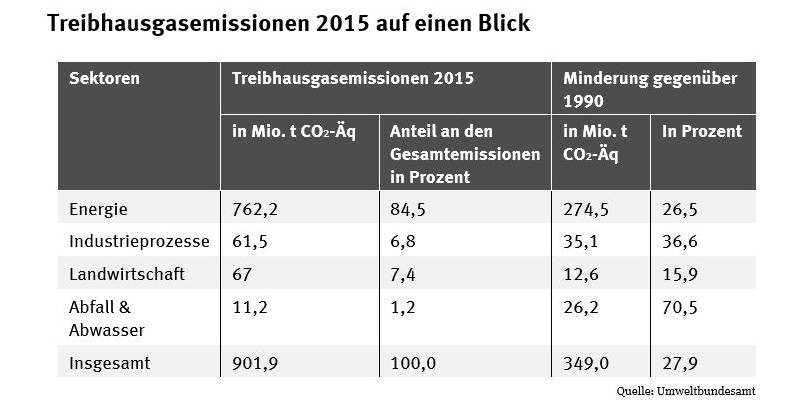In contrast, transport sector emissions, which are included in the figure for the energy sector, rose slightly again. The sector’s 160.8 million tonnes GHG emissions for 2015 equal nearly 0.7 million tonnes of CO2 equivalents more than the previous year. The reason for the increase is a greater volume of road traffic, thus continuing the trend of recent years. "The numbers show that transport emissions can only decrease if we give electric mobility a chance,” said Ms Krautzberger.
Climate change mitigation is also at a standstill in the agriculture sector, where 2015 emissions once again rose by about 0.5%. Although the sector’s emissions are still about 16% lower than in 1990, emissions have practically returned to the level in 2000, after reductions had been recorded in the early years of the millennium. The causes of this trend in agriculture, as in the previous year, are due to higher emissions from liming and the use of urea-based fertilisers.
Industrial process GHG emissions remained virtually stable. Emissions abatement of less than 1 million tonnes of CO2 equivalents in the chemicals and minerals industry are practically offset by increases in emissions in the metals industry and other industrial sectors.
Emissions, by greenhouse gas
Carbon dioxide (CO2) was again the most prevalent gas in 2015 (87.8%), largely accounted for by the combustion of fossil fuels. This is followed by methane (6.2%) and nitrous oxide (4.3%), mainly due to agricultural activities. Carbon dioxide emissions reductions have declined by 24.7% over 1990 levels. Methane (CH4) emissions are 53.7% lower than in 1990; nitrous oxide (N2O) has been cut by 39.8%.
Fluorinated greenhouse gases (F-gases) account for only about 1.6 per cent of GHG emissions, but some have a very high global warming potential (GWP). The trend for these gases is less regular: the introduction of new technologies and the use of these substances as substitutes for other chemicals has resulted in reductions of sulphur hexafluoride (SF6) and hydrofluorocarbons (HFC) emissions of 44.9% and 87.8%, respectively, since 1995. However, emissions of halogenated HFC have risen by 38.2% over the same time period. Emissions of the fluorinated gas nitrogen trifluoride (NF3), which has recently become subject to reporting duties, has risen by 124.7 per cent from its low level in 1995.
Further information
The discrepancies between the preliminary calculations of the 2015 GHG emissions which were published in Press Release 09/2016 of 17 March 2016 are due to updates to the sparse preliminary data which was available at the time.
Greenhouse gas inventories, 1990-2015




